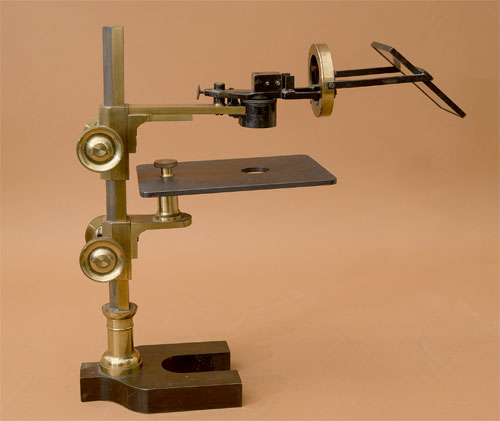 |
|||||
 |
 |
||||
 |
|||||
 |
 |
||||
Nachet Dissecting Microscope with Camera Lucida (No. 326) |
||||||||
 |
||||||||
| Age: 1892 Made by: Nachet et Fils Made in: Paris |
||||||||
 |
||||||||
|
Nachet et Fils
17 rue St. Severin Paris |
||||||||
| This is a quite rare example of the large model of Nachet's "Chamber claire loupe perfectionée", or Improved Camera Lucida magnifier. This model was introduced in the Nachet catalog of 1892 (Number 82, pp 69-70). It sold for 30 French Francs. The instrument is a dissecting microscope with a simple, plano-convex lens for the objective. The magnification is approximately 2.5x. What is interesting about this microscope is that it has an integrated "camera "lucida" optical mechanism. This consists of a Wollaston prism that when configured will join two images: the sample and a reflection of the drawing paper. The way it would work is that you would look through the prism and see both the sample as well as you're drawing paper. This would allow you to trace the object onto the paper, creating a perfect rendering of the sample. One problem was that when using Wollaston's prism white drawing paper would wash out the image of the sample. The solution was to use black drawing paper and draw with a white pencil.
The microscope body consists of an angular pillar fixed to a heavy horseshoe base. The pillar supports the stage and objective cantilever, both of which can be focused via Rack & Pinion. The rack is machined into the pillar. Just behind the objective is a locating pin for mounting the camera lucida attachment. The attachment consists of a Wollaston prism (intact) and a rectangular mirror mounted to a circular ring. The ring allows the mirror to be rotated to accommodate off-axis drawing paper. There is no mirror for illuminating the sample with this instrument. It is probable that the mirror was free-standing, as there is no mounting mechanism on the support pillar. The camera lucida was patented by William Hyde Wollaston in 1806. Wollaston also invented a prism that was initially used to create binocular vision microscopes and later modified by Georges Nomarski to create Differential Interference Contrast microscopy. To see variations of Wollaston's Camera Lucida see Microscopes No. 149 , 167, and 315. This microscope is stamped "460" in four different locations. This number is probably the serial number of this particular instrument. On the top of the objective cantilever is engraved "Nachet et Fils, 17 rue St Severin, Paris". Microscope featured 08/2019 |
||||||||